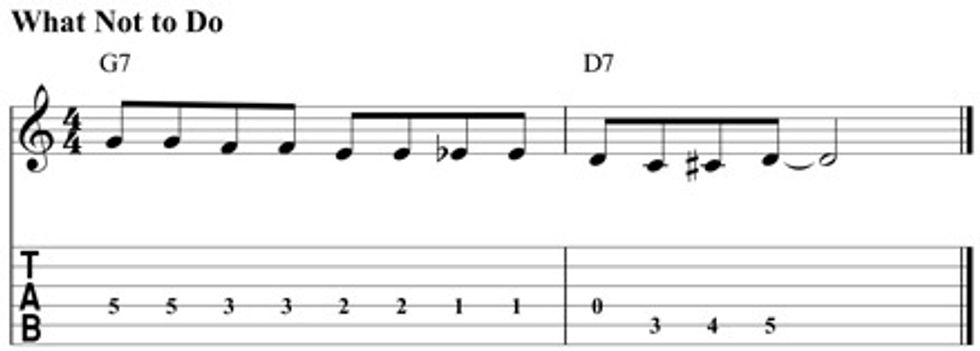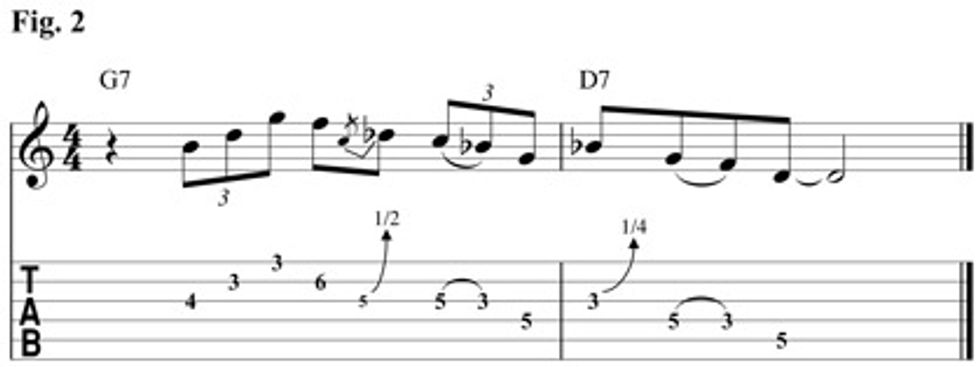Chops: Beginner
Theory: Beginner
Lesson Overview:
• Learn what not to do over a turnaround. Ever.
• Create licks in the style of the three Kings.
• Understand how to relate a Norwegian limerick to developing a blues vocabulary.
Hello ladies and gentlemen, ’tis I, the Kid. In this lesson, we’ll be digging deep into the extended vocabulary of blues guitar. Nothing exemplifies the phrase “a minute to learn, a lifetime to master” better than this uniquely American art form. For inspiration, look to some of the originators of this musical language to help you write your own chapter in this highly expressive style. That’s how all the true greats in blues and rock made their discoveries.
To me, the blues is simultaneously as much about tradition as it is about originality. You learn the language by going back to the origins, then the more “words” and “phrases” you know in this language, the more colorful and interesting your own story will be when you tell it. You might think that knowing a blues scale and the 12-bar form, having a tube amp and an electric guitar, and arming yourself with a few blues licks is all you need to wail.
But with these alone, you have as much chance of making a real statement in blues as I do writing a great limerick in Russian. To illustrate, here’s one in Norwegian, which I was raised speaking, but you hopefully weren’t:
Jeg kjente ei jente fra Moss,
som likte å drikke og slåss.
Hun begynte å spy,
hver gang dagen var ny
men jeg giftet meg med ’a til tross.
Thank you for indulging me. You probably recognize the limerick form in these words, and you may even think you know the words “moss,” “spy,” “gang,” “men,” and “med,” but I defy you to be able to relay this short tale in your own words if you don’t speak the Norwegian language. (Hint: It’s about a woman who enjoys drinking, fighting, and vomiting.) You get my point, I hope.
That’s not to say that I think every guitar player out there should know every Robert Jr. Lockwood turnaround to demand respect. I’m actually not what you would call a blues purist myself. I personally draw on everything from jazz, surf, and rockabilly to country, metal, and baroque. However, the blues is my mother tongue on the instrument and if I were to quote George Benson or Tony Iommi during some extended guitar freakout, it’s more the equivalent of me shouting out nostrovia! (cheers) in a Russian crowd.
One of the beautiful things about this incredible art form is that with the right conviction behind it, blues can fit in just about any kind of music for two reasons: First, it’s at the root of most modern Western music, and second, it’s cool as hell. Just try sneaking one of these licks I’m fixin’ to show you into your next Indian raga, Bach lute suite, or head-banging anthem for the glorification of the dark lord. You can’t fail. Okay, enough preaching. Allow me to show you some licks and tricks you may not be hip to.
I’m going to start off at the end, as all these licks apply to the last two measures or so of a 12-bar progression, when you return to the I chord after the V and IV of the turnaround. We will call Fig. 1 “What Not to Do.” Nothing reveals a blues novice more than someone who fumbles and plays square, rhythmically awkward licks that break up the groove, and most of all, over-emphasize an anticipated V chord at the very end of the progression. You’ve heard this a million times, which is why it has to end!

As with all my rules, there are many good exceptions, but unless you were born of sharecroppers in the rural South, this one is hard to pull off with your dignity intact, especially the last three notes.
Instead, end your epic solo with Fig. 2, which is straight out of the book of Freddie King. Also make sure to practice at home the accompanying “I smell a fart” stare. Perhaps you didn’t want the crowd to think you were about to murder them, and felt like ending on a lighter note. In that case, I would suggest using Fig. 3. Which reeks of the one and only king of the blues, B.B. King. Cool thing about that, it implies a suspended V chord at the end, taking us back to church. Where we should have been all along! Suggested facial expression: The difficult bowel movement.


Lastly, no grimace needed to cop this Albert King-inspired slow blues ending in Fig. 4, though to really nail his vibe, you may have to clamp a pipe between your teeth.

Again, all these licks can work on everything from “Red House” to “Shake Your Moneymaker” to “Slow Ride.” You don’t really have to be at the end of the 12 bars. Hey, it’s blues. If there’s nothing else you take away from this lesson, please don’t ever make me hear Fig. 1 again!
 Kid Andersen Currently the guitarist for Rick Estrin & the
Nightcats, Kid Andersen has recorded and
performed with Charlie Musselwhite, Elvin
Bishop, and many other blues legends.
Originally from Norway, Andersen is now based
in San Jose, California, with the immigration
status of “Alien of Extraordinary Ability.” For
more information, visit rickestrin.com.
Kid Andersen Currently the guitarist for Rick Estrin & the
Nightcats, Kid Andersen has recorded and
performed with Charlie Musselwhite, Elvin
Bishop, and many other blues legends.
Originally from Norway, Andersen is now based
in San Jose, California, with the immigration
status of “Alien of Extraordinary Ability.” For
more information, visit rickestrin.com.
















